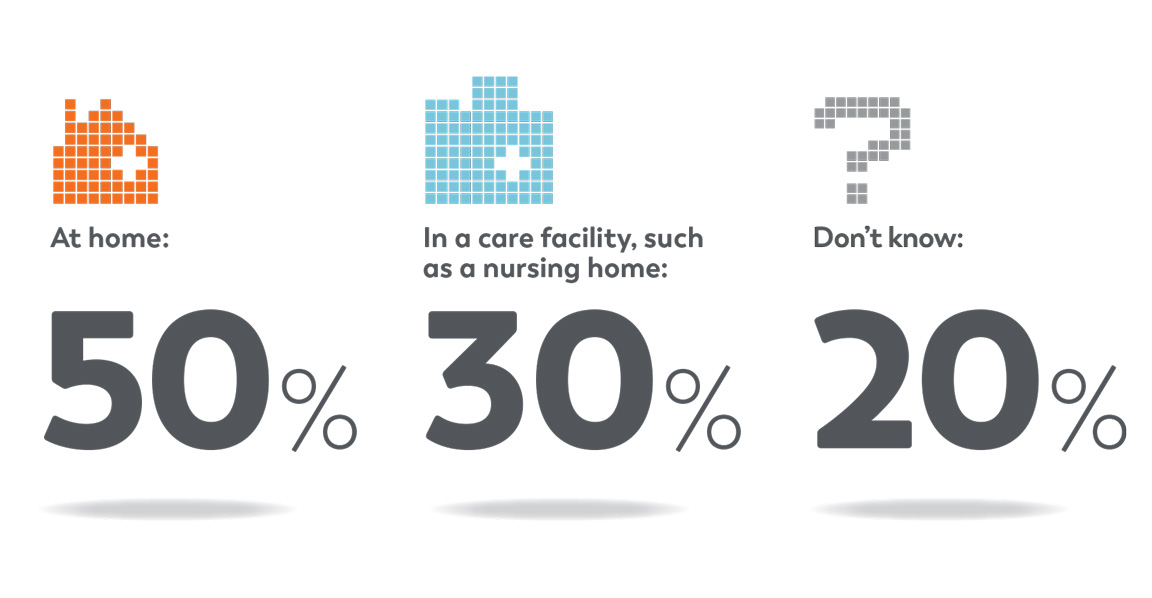Overcome Barriers to Facility-Based Care with What Families Value Most
The COVID-19 pandemic ushered in a new era of skepticism – and even fear – from families regarding the safety and quality of care at facilities such as nursing homes. Mass media focused on major outbreaks of COVID at facilities, calling them “petri dishes” for the virus.
So it wasn’t too surprising when a national survey conducted by Transcend Strategy Group in 2020 revealed a major shift in family caregivers’ perceptions about the best place for seniors to receive care. Up to 51% of survey participants said they are “less likely” or “definitely won’t use” facility-based care for a family member, if they have a choice. Only 33% said they were more confident in the quality of care provided in a facility compared to 60% greater confidence in care provided at home.
A new follow-up study from Transcend released earlier this year shows these perceptions haven’t waned even as COVID vaccines and protocols have greatly lessened the impact of the virus. Among family caregivers, 59% say they would be more hesitant about a loved one receiving care at a facility versus only 6% hesitancy for a loved one receiving care at home.
When asked their opinion on the place for seniors to receive the best care for a serious illness, responses broke down like this:

With these perceptions prevailing, it’s no wonder that many facilities have experienced a significant drop in census, which they’re still struggling to rebuild. Some providers ended up going out of business.
If you’re a provider of facility-based care, what do you do to overcome these substantial obstacles and rebuild the trust necessary to rebuild your census?
Fortunately, the latest study from Transcend also revealed why some families prefer care in a facility based on what they value most. In a nutshell, those vital attributes boil down to your expertise, access and resources.
Let’s take a look at each of these values and how you can leverage them to build preference for care at your facility. And remember – the 20% listed above who “don’t know” the best place for senior care are open to being convinced that facilities such as yours are the answer.

Promote the Depth of Your Expertise
The top reason (at 41%) that families cited as a preference for care in a facility was “professional, trained/specialized staff.” Families also value that expert staff is on-site 24/7 and can quickly respond to any situation.
Survey respondents noted they like having “several certified healthcare professionals in one place” and that their loved one “would receive around-the-clock care by professionals.”
What to Do:
Promote the breadth and depth of your staff. Let families know that you have an expert team of doctors, nurses, therapists, social workers, dietitians, aides and more – either in the facility or on-call at a moment’s notice (whatever your case may be).
Cite credentials, if appropriate. Do you have staff members who are board-certified in medical specialties or have other impressive certifications? How does the expertise of your team compare to those of your competitors? Leverage any advantage you have to indicate the quality and professionalism of your team.
Partner for added expertise. If you don’t have the budget for certain full-time specialists on-staff, consider partnering with other community providers to complement your care. For instance, many hospice and palliative care providers would be eager to forge a regular partnership with you, bringing in their specialized expertise in pain and symptom management, as well as end-of-life care. With such support, the resident stays in your facility while receiving additional expertise families crave.

Spotlight All the Resources You Have in One Convenient Location
In addition to your personnel’s expertise, families like the idea of having advanced resources in the same location as where their loved ones are living. Comments in our survey about preferring facility-based care included “they have all necessary resources and personnel immediately available” and the comfort in knowing there’s “specialized medical equipment and prescription handling experience.”
What to Do:
Showcase your medical equipment and other technology. Let families know you are equipped to handle most of their loved one’s medical needs without them having to leave their familiar surroundings.
Emphasize the features of your facility. Do you have an impressive rehab center with a lot of equipment for therapies? How about a pool for aquatic therapy or recreation? Patients who are receiving care at home often have to travel to a clinic or other location to receive such services at the level you’re able to provide in-house.
Remember the resources that enhance daily life. Of course, your residents’ lives are much more than their medical conditions and needs. What amenities do you have that enable daily exercise, socialization, entertainment and other factors that improve the quality of life every day?
Play Your Power Card: Access
For families, the multiplier of your expertise and resources is the quick access their loved ones will have to these advantages by extreme proximity.
The second highest trait (at 38%) that families cited as their preference for facility-based care is “access to staff or equipment.” One survey respondent summarized by saying they appreciate “quick access to medical intervention if needed.”
Families also highly value easy access to information. When asked to rank the most important benefits of receiving care at a nursing center, the second and third overall top answers (behind only “compassionate staff”) were “having a system in place to communicate with family members in the event of a crisis” and “family access to medical information (such as through an app) to monitor the resident’s health without having to call for information.”
What to Do:
Define your team’s responsiveness. Since quick access to your staff’s expertise is so important to families, how can you demonstrate the speed or ease to respond? Do you have quick response times to call lights? Do you schedule requested appointments or conversations quickly? Do you have a good staff-to-patient ratio (especially compared to competitors) that allows quicker and higher quality service to your residents?
Make sure you have strong communication tools for families. The COVID pandemic exposed the flaws in many facilities’ communication protocols with families. When family members couldn’t see their loved ones and facilities were in lockdown crisis, the lack of communication was a major pain point. Most facilities couldn’t handle the flood of phone calls from families, which was the primary way to communicate. Use today’s technology to have quick and easy communications with family members. Whether it’s through emails or texts (which can be automated and blasted out) or through an app that allows direct contact with identified team members, make it simple for families to reach you and easy for your team to respond quickly or at a regular cadence.
Consider an app that allows instant family monitoring of their loved one’s condition. Several apps are already on the market – and more continue to emerge every year – that are HIPAA-compliant and enable approved family members to check in on their loved one’s medical information and other details (e.g., is Mom eating well?) at any time, from anywhere in the world. A major obstacle of having a loved one living in a facility can be a family member’s guilt about not seeing them often or not being in touch as much as they’d like. Imagine the peace-of-mind and confidence family members could have from being able to check in on a loved one whenever they want and follow up with any questions or comments. Transparency with your residents’ conditions each day goes a long way to building trust – the key to building back your census.
Want to know more about how to implement these ideas into your protocols and marketing? Feel free to email me at stan@transcend-strategy.com.











